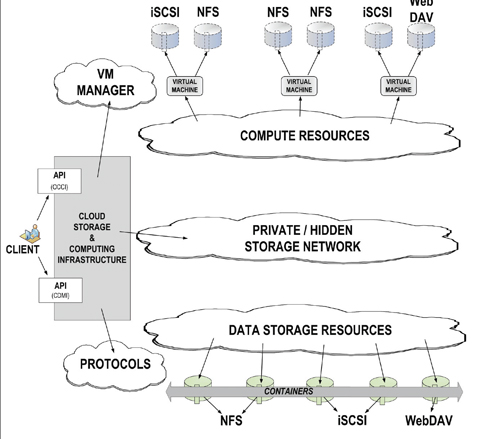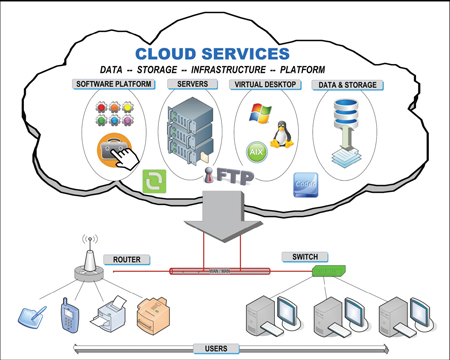Cloudy With a Change in Storage

Karl Paulsen
Today’s clouded networking and storage environments are a little like the Wild West. Innovators and entrepreneurs alike are aligning definition to technology, applying marketing for new perspectives and finding applications that can serve the masses; all while attempting to achieve a level of comprehension for what the cloud offers as a value proposition.
Organizations are anxiously looking to leverage the cloud for its storage and service applications. Unfortunately, we’re seeing growing confusion, a hunger for more definition and a thirst for viable secure applications. Nonetheless, the law and disorder of cloud technologies seems to have already created a quantum shift in the future of storage and networked services.
Looking at the continuing development of activities surrounding the cloud, quite a bit needs to be understood in order to allow users the opportunity to better place their potential “cloud needs” into a proper framework. Over the next few installments of this column, we’ll put some dimension to what the cloud is, what it offers and how the cloud fits into your organization.
We start by discussing the origin of the cloud; which began as that infamous “cloud icon” on network topology diagrams. The term actually came directly from those architectural drawings that used a cloud symbol as the ubiquitous networking icon. Conceptually, the cloud then represents “any-to-any” connectivity in a private or public network infrastructure. Fig. 1 shows a generalization of the cloud which may provide an enormous level of services to a multitude of users.

Fig. 1: A generalization of the cloud, which can provide many services to many users
CLOUD SERVICES OR STORAGE?
The answer is yes. Cloud services should be distinguished from cloud storage in similar fashion to the way an application living on a PC is distinguished from the storage connected to or contained on that same PC.
The professional video industry's #1 source for news, trends and product and tech information. Sign up below.
Essentially, cloud storage is a repository for bits. The cloud may have no more management sophistication than what you’d find on a PC attached to a shared drive that has simple, defined privileges such as read/ write rights and access conditions.
A service, when set in the cloud, can be another aspect of the cloud architecture. Cloud services provide value-added benefits such as pay as you go; pay only for what you need; elasticity, i.e., the illusion of infinite capacity; and of course the simplicity of use and/or management of the data storage or services.
The cloud may also provide functional operations—applications—that may be utilized by multiple users who request (and pay) for those functions.
A user may only choose to put their data into a storage bin that is located in the cloud. Often these storage services will provide the usual redundancy and backup protection, secure accessibility from multiple locations and shared access depending upon the rights and privileges established by the user/administrator.
DropBox and Carbonite, both popular commercial file-sharing and backup storage solutions (respectively) are good examples of where a storage provider, anchored in the cloud, provides fundamentally basic services for a price that is economical, very simple and quite functional for millions of users. They both rely on a public network for access, and have specific user-defined sharing and access rights that are established by the primary user of the account.
Cloud services, on the other hand, offer an extended set of capabilities that can include functionality such as content delivery management (CDN), transcoding, processing and even “cloud-editing.”

Fig. 2: A method of how cloud services can be virtualized to provide data storage and compute resources to users
ON DEMAND THROUGH VIRTUALIZATION
An important part of the cloud model is the concept of an “on-demand” resource pool that allows sets of resources to be drawn from in small increments. The scale of the resource pool is often concealed and is therefore transparent to the individual user.
Because this resource pool is collectively shared among many users, all with potentially differing sets of needs, the costs of those services for any one user will generally be much less than if the same user were to purchase the equipment that performs those services themselves. This relatively recent innovation is made possible through virtualization.
In similar fashion, cloud storage is simply the delivery of on-demand virtualized storage. When storage services are delivered over a network of appropriately configured virtual storage and related data services and are founded on a request for a given service level; the service is referred to as “Data Storage as a Service (DaaS).” Fig. 2 shows another method of expressing how cloud services can be virtualized to provide data storage and compute resources to users.
As discussed in Al Kovalick’s article, “The Cloud: What’s It All About?” (Cloudspotter’s Journal, Aug. 22, 2012), other provisions are also available in the cloud. Those being considered in standards development activities include “Infrastructure as a Service (IaaS).” This concept enables the delivery, over a network, of an appropriately configured virtual computing environment based on a request for a given service-level agreement (SLA). IaaS may be either self-provisioned or provisionless. Like other cloud services, IaaS is billed based on the user’s consumption of those services.
When a virtual programming environment is needed, such services may also be delivered over a network consisting of an application deployment stack based on a virtual computing environment. This is called “Platform as a Service (PaaS)” and is based on IaaS. PaaS can be either self-provisioned or provisionless, is billed based on consumption, and provides an application deployment stack that is called for on demand.
“Software as a Service (SaaS)” is yet another capability that can be virtualized in the cloud. The previous example of cloudbased transcoding services is a good representation of SaaS.
CLOUD STANDARDS
Cloud standards are intended to define and establish the functionality of the various resources that might be offered as services within a rich cloud environment. In these models, clients are exposed to resources as data paths. More precisely, the data paths are “functional interfaces” that are managed by control paths otherwise known as “management interfaces.” To make this work on a universal basis, cloud standards are being developed and adopted so as to allow a semblance of uniformity regardless of the storage or services architecture supported inside the cloud.
Metadata becomes an extremely important concept in the cloud data management specification. Metadata is a convenient mechanism used to express the management of large amounts of data with differing requirements. The management toolset is one of the underlying data services that differentiate the treatment of the data in order to meet the intended requirements.
There is a great deal more to uncover in the cloud. In a future issue, we’ll get into how cloud services and cloud storage is built out using SoA (Service Oriented Architectures), the defining of SLAs, and how the cloud is utilized from the user and the cloud provider’s perspective.
Karl Paulsen (CPBE) is a SMPTE Fellow and chief technologist at Diversified Systems. Read more about these and other storage topics in his recent book “Moving Media Storage Technologies”. Contact Karl atkpaulsen@divsystems.com.

Karl Paulsen recently retired as a CTO and has regularly contributed to TV Tech on topics related to media, networking, workflow, cloud and systemization for the media and entertainment industry. He is a SMPTE Fellow with more than 50 years of engineering and managerial experience in commercial TV and radio broadcasting. For over 25 years he has written on featured topics in TV Tech magazine—penning the magazine’s “Storage and Media Technologies” and “Cloudspotter’s Journal” columns.
